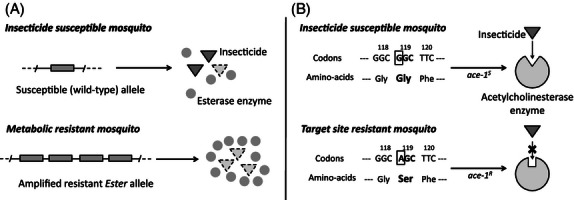Figure 1.

Insecticide resistance in Cx. pipiens. (A) Metabolic resistance. It consists in the overproduction of a large amount of detoxifying carboxylesterases (Raymond et al. 2001), which is achieved by the tandem amplification of two paralogous esterase loci esterase-3 (encoding for the esterase A) and esterase-2 (esterase B). These two genes are in strong linkage disequilibrium and are commonly referred to as an Ester superlocus (Berticat et al. 2001). (B) Target site resistance. The modification of the acetylcholinesterase enzyme in Cx. pipiens is controlled by the locus ace-1. The most prevalent alleles for this locus are the wild-type susceptible ace-1S and the insecticide resistant ace-1R, which contains a single point mutation that renders the acetylcholinesterase enzyme insensitive to the insecticide. This point mutation is identical to the one found in acetylcholinesterase resistant Anopheles gambiae and A. albimanus mosquitoes (Weill et al. 2003; Weill et al. 2004).
